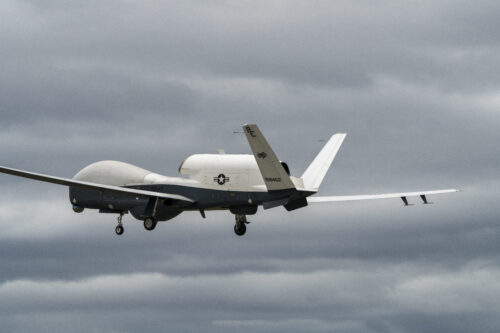The United States military will deploy several MQ-4C Triton surveillance drones to Kadena Air Base in Okinawa Prefecture for an indefinite period, Japanese defense officials announced Apr. 8. The unmanned aircraft are expected to begin operations within weeks, following a previous temporary deployment last year from May to October.

Squadron 19 (VUP-19) departs Marine Corp Air Station
Iwakuni, Japan, Oct. 5, 2022. Due to its geographic
location and co-located airfield and harbor, MCAS
Iwakuni is uniquely postured to provide advanced naval
integration in support of regional security. (U.S. Marine
Corps photo by Cpl. Mitchell Austin)
The deployment comes as part of a joint effort to enhance intelligence, surveillance, and reconnaissance capabilities in response to growing security concerns in the region, according to Japan’s Ministry of Defense and Ministry of Foreign Affairs.
“This deployment demonstrates the United States’ unwavering commitment to Japan’s defense and will strengthen surveillance capabilities in the areas surrounding Japan,” Defense Minister Gen Nakatani told reporters at a press conference in Tokyo.
The decision to station the advanced drones in Japan’s southernmost prefecture reflects increasing concerns about maritime activities in the East China Sea and surrounding waters. Chinese vessels have been conducting regular operations around the Japanese-administered Senkaku Islands, with government data showing extended incursions into territorial waters.
Officials also cited ongoing “ship-to-ship” transfers conducted by North Korean vessels in violation of international sanctions, as well as joint Russian-Chinese bomber flights in the East China Sea as factors necessitating enhanced monitoring capabilities.
Okinawa, situated along a chain of islands stretching southwest from Kyushu toward Taiwan, occupies a strategic position for monitoring these activities. The prefecture faces the East China Sea where Chinese military operations have intensified in recent years.
The Triton represents a significant upgrade in surveillance technology compared to other unmanned aircraft currently operating in the region. Unlike the smaller MQ-9 Reaper drones stationed at Kadena since 2023, which operate at lower altitudes to provide detailed imagery of specific targets, the Triton specializes in wide-area maritime surveillance. The aircraft can monitor vast ocean regions while collecting both imagery and signals intelligence.
Defense officials emphasized that the Triton is an unarmed platform designed exclusively for reconnaissance purposes. The drone uses a derivative of jet engines typically found in smaller commercial aircraft, resulting in significantly lower noise levels than fighter jets.
The announcement has met with resistance from local Okinawan officials. Governor Denny Tamaki issued a statement opposing the deployment and calling for reconsideration.
“We strongly demand that the deployment plan be reconsidered and that our burden be reduced in a visible manner,” Tamaki said, highlighting concerns about the continued concentration of U.S. military assets in the prefecture, which already hosts the majority of American military installations in Japan.
Local anti-base activists have long protested the outsized share of the U.S. military footprint borne by Okinawa, which accounts for less than one percent of Japan’s land area but hosts about 70 percent of U.S. military facilities in the country.
The Defense Ministry stated that flight paths would prioritize ocean routes to minimize flights over populated areas, with aircraft departing and approaching via the shortest routes to open water.
The deployment also coincides with efforts by both the U.S. and Japan to strengthen their defense cooperation. Japan has been expanding its own reconnaissance capabilities, including the deployment of its own RQ-4 Global Hawk drones at Misawa Air Base since 2021.
The permanent stationing of Tritons in Okinawa is expected to draw reactions from Beijing, which has consistently objected to what it characterizes as U.S. military expansion in the region. Chinese foreign ministry spokespersons have previously criticized U.S. reconnaissance activities near Chinese territory as provocative.
Defense officials declined to specify exactly how many aircraft would be deployed, describing it only as “several” units. They also did not indicate an end date for the deployment, suggesting a long-term commitment to maintaining this surveillance capability.
For more information, hit the Source below